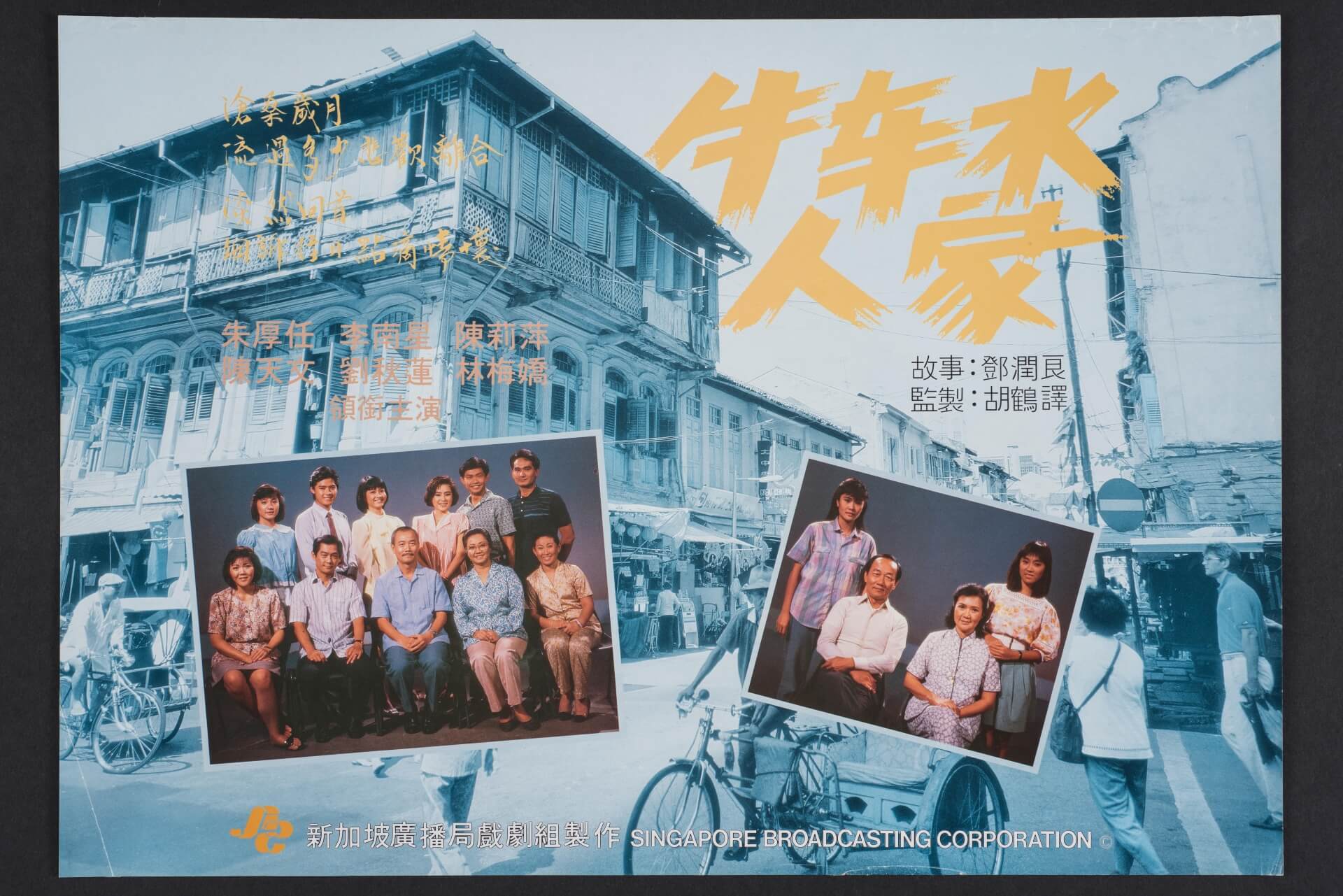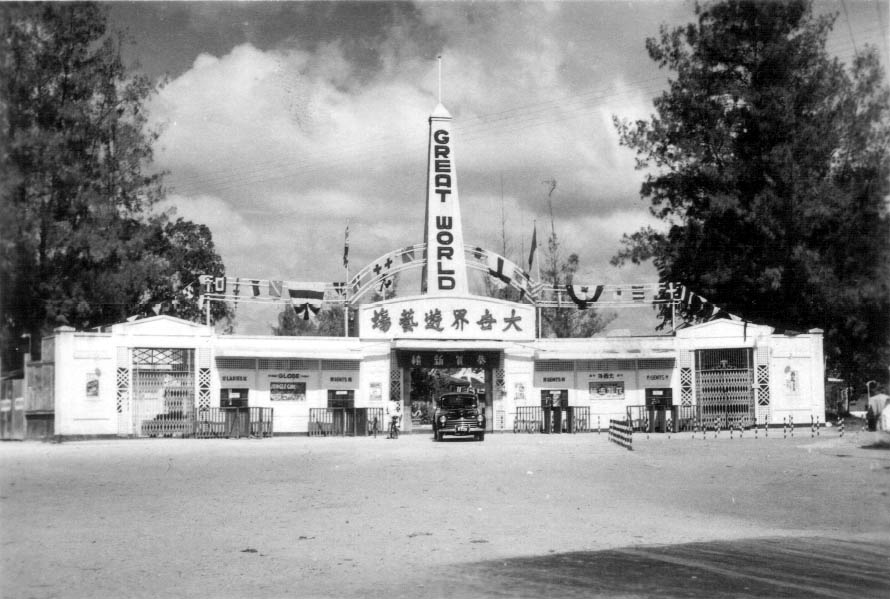Local Chinese programmes in the Singapore Broadcasting Corporation era (1980–1993)
In 1980, the government restructured Radio and Television Singapore (RTS) to become the statutory board Singapore Broadcasting Corporation (SBC). This was in a bid “to free the Department of Broadcasting, Ministry of Culture, from administrative and financial constraints so that the organisation can expand and develop into a lively radio and television station”.1
From the very beginning, local television was tasked with the triple mission of informing, educating, and entertaining. In the RTS era, drama programmes primarily functioned as a means of social education through dramatic storytelling, and their entertainment value was relatively low. Following the establishment of SBC, local Chinese television drama began to shift its emphasis towards entertainment.
Chinese Drama Unit
To increase viewership and attract advertisers, SBC started recruiting television talents, mainly from Hong Kong,2 to collaborate with local teams to increase the quantity and quality of its programmes. In 1980, SBC officially established the Chinese Drama Unit (later renamed Chinese Drama Division), hiring scriptwriters and full-time actors. In 1982, the one-episode drama Seletar Robbery paved the way for more local productions. The following year, in 1983, SBC released a number of television series,3 including the six-episode Army Series, a military-themed drama filmed with the support of the Singapore Armed Forces.

In 1984, the release of The Awakening, a four-part series consisting of 53 episodes, propelled locally-produced television series to new heights. It saw the involvement of Hong Kong television veterans, with Lai Shui-ching as executive producer and Leung Lap-yan (1948–2020) and Jiang Long as writers. The epic drama series spanned the period from British colonisation and the Japanese occupation to post-war reconstruction, independence, and Singapore’s economic take-off, highlighting the experiences of the Chinese who sailed south to settle in Singapore. That year, SBC also released its first locally-produced martial arts drama The Pursuit.


From 1985 onwards, SBC produced multiple drama series with more than 20 episodes every year, marking a shift towards an era of mass production in local television. In 1986, the 510-episode long-form drama Neighbours was released, airing for two years. Its theme song “Voices from the Heart” is still widely performed and enjoyed by Singaporeans. The Coffee Shop, released in the same year, later became the first local drama series to hit one million viewers.4
The dubbing unit
In 1979, RTS set up a dubbing unit in response to the Speak Mandarin Campaign. Its initial function was to translate Hong Kong television dramas into Mandarin. After the establishment of SBC the following year, the dubbing unit proved invaluable as many of the recruited actors had a less than desirable proficiency in Mandarin. Seletar Robbery was the first local drama to be dubbed. As the volume of production increased, the dubbing of local programmes became the focus of the unit’s work. It was not until the late 1990s that local television series featured the original voices of the cast. 5
Seeing as Chinese television dramas were so well-received locally, SBC decided to dub some of its more popular Chinese series into English to widen their reach. The first Chinese serial dubbed in English was Samsui Women, followed by Army Series, The Coffee Shop, On the Fringe, Against the Wind, Crime and Passion, and others. This not only allowed the Chinese who did not understand Mandarin, but also fellow non-Chinese Singaporeans, to enjoy locally-produced television drama series.6
In the 1990s, Singapore television series were not just popular locally, but seen as a form of soft power. Besides being exported overseas to Hong Kong, Taiwan, Japan, Thailand, Malaysia, Australia, the United States, and Canada, among others, these series also gained a huge following in China.7
Variety shows
Apart from dramas, variety shows were another mainstay in Chinese programming. Live from Studio One series, which began with Live from Studio One Friday8 in May 1981, was considered the vanguard of variety shows in the 1980s. Due to positive viewer response, Live from Studio One Monday and Live from Studio One Wednesday were added. At the end of 1983, the show aired every day of the week from Monday to Friday, and was collectively renamed Live from Studio One at 8:30 p.m.. In 1987, it merged with Family Hour in the evening slot and was renamed Studio One Presents.9 The series did not end until 1991, when Variety Tonight10 took over.
Variety shows in this period also included games, trivia, and skits, in addition to song and dance. Wang Sha (1925–1998) and Ye Feng (1932–1995), who were popular in the 1970s for their dialect comedies, continued to bring laughter to Singaporeans through their participation in these Chinese variety shows in Mandarin in the 1980s. At the same time, a new generation of comedy stars such as Hua Liang (1953–1995) and Zhao Jin rose to prominence, alongside emerging talents like Jack Neo and Moses Lim. These performers aimed to educate their audience while entertaining them through skits and comedy.
The production of Chinese television programmes in the SBC era not only increased in quantity, but improved in quality as well. With limited television channels in the 1980s, locally-produced Chinese programmes that aired during primetime slots mostly made the top ten in ratings, with viewership easily starting from 500,000 to 600,000 and peaking at over a million. These Chinese-language programmes were the main driver of SBC’s viewership ratings and, more importantly, allowed viewers to engage with local stories and topics on the small screen. These stories reflected the shared values of citizens in a country that had diverse ethnicities, languages, religions, and cultures.
This is an edited and translated version of 新广时期的华语自制节目(1980-1993). Click here to read original piece.
| 1 | “Xin chengli de xinjiapo guangbo gongsi yingye fangzhen jiang shou kongzhi” [Newly-formed Singapore Broadcasting Corporation’s business policies to be regulated], Sin Chew Jit Poh, 23 September 1979. |
| 2 | Man Shu Sum, “Lanhaiyang zhi lu” [Blue ocean journey], in Huiwang jialigu shan [Reflections of Caldecott Hill], 193–197. |
| 3 | “Zouxiang fengshou de xin yi nian” [Towards a prosperous new year], Nanyang Siang Pau, 17 December 1982. |
| 4 | “Xinguang Kafeiwu po bendi jiemu shoushi jilu” [SBC’s The Coffee Shop breaks local programme viewership record], Lianhe Wanbao, 4 March 1986. |
| 5 | Lee Yong Tick, “Ba wanmei shengyin jie gei piaoliang de lianpang: Dianshitai peiyin zu” [Lending the perfect voice to beautiful faces: SBC’s dubbing unit], in Huiwang jialigu shan [Reflections from Caldecott Hill], 255–259. |
| 6 | Tan Yew Soon and Soh Yew Peng, The Development of Singapore’s Modern Media Industry (Singapore: Times Academic Press, 1994), 83–84. |
| 7 | Soh Choon Heng, “Liang Li Ren yu Jiang Long: Dailing huayu xiju pan gaofeng” [Leung Lap-Yan and Jiang Long: Leading Chinese drama production to new heights], in Huiwang jialigu shan [Reflections from Caldecott Hill], 223–231. |
| 8 | “Guangboju ji Gewu Jin Xiao zhihou, ben zhouwu tui Binfen Xingqiwu, Zhang Wei du tiao daliang, Zheng Yu Ling jieshou fangwen” [SBC’s Song and Dance Tonight will continue to air on Live from Studio One Friday this Friday, with Zhang Wei as solo host and Carol Cheng as interview guest], Shin Min Daily News, 6 May 1981. |
| 9 | Douqu, qingsong, rexiao, chuanda shenghuo xunxi, Huanle Binfen quanxin baozhuang” [Engaging, light-hearted, funny, and full of life lessons, a brand new Studio One Presents], Lianhe Zaobao, 27 March 1987. |
| 10 | “Huanle Binfen quanxin chuji, mingnian qi gaiming Kaixin Wu Chong Zou” [Studio One Presents will be revamped and renamed Variety Tonight starting next year], Lianhe Wanbao, 18 December 1990. |
Tan, Yew Soon and Soh, Yew Peng. The Development of Singapore’s Modern Media Industry. Singapore: Times Academic Press, 1994. | |
Tay, Philip J., Choo, Lian Liang et al., eds. Huiwang jialigu shan [Reflections from Caldecott Hill]. Singapore: Global Publishing, 2021. |










